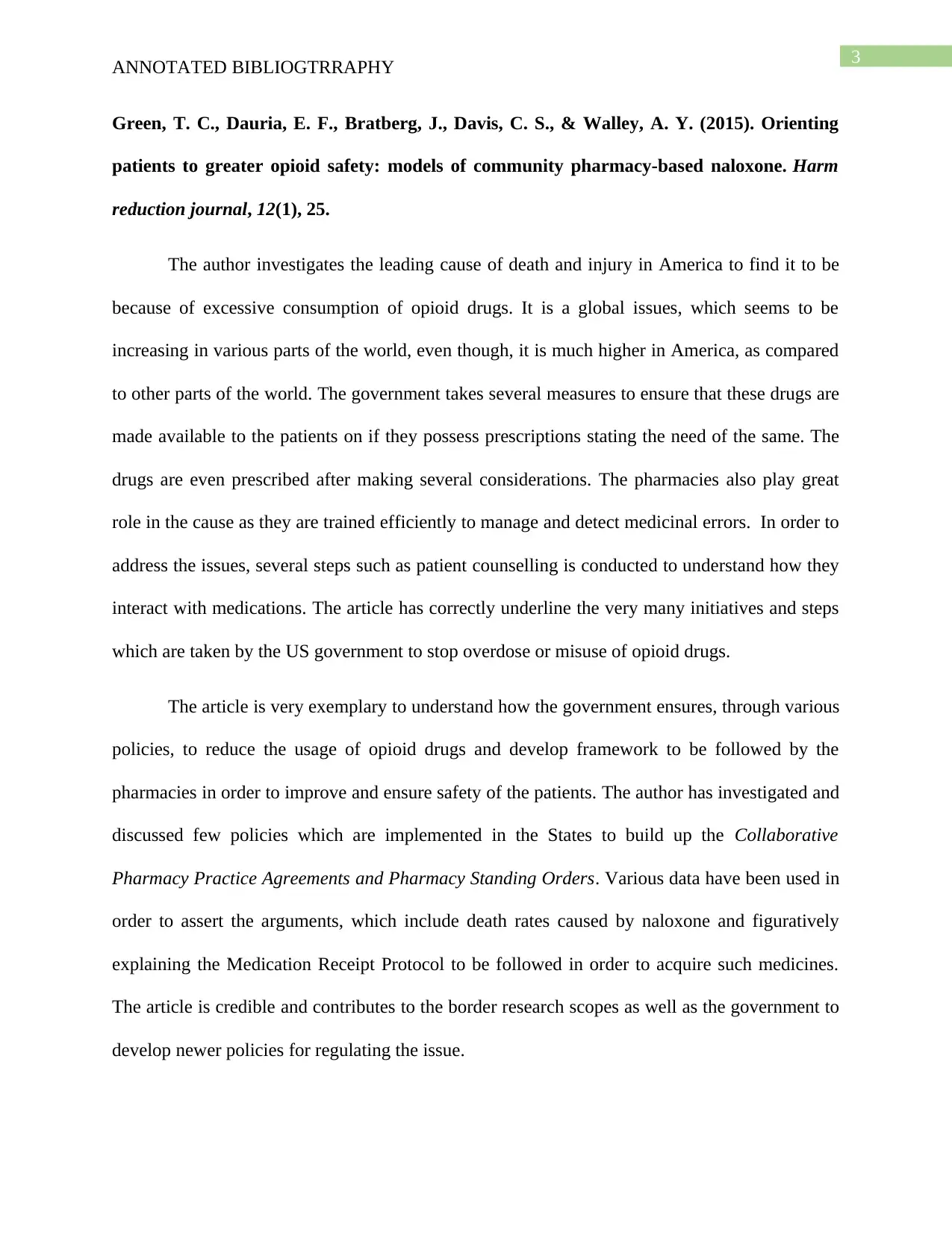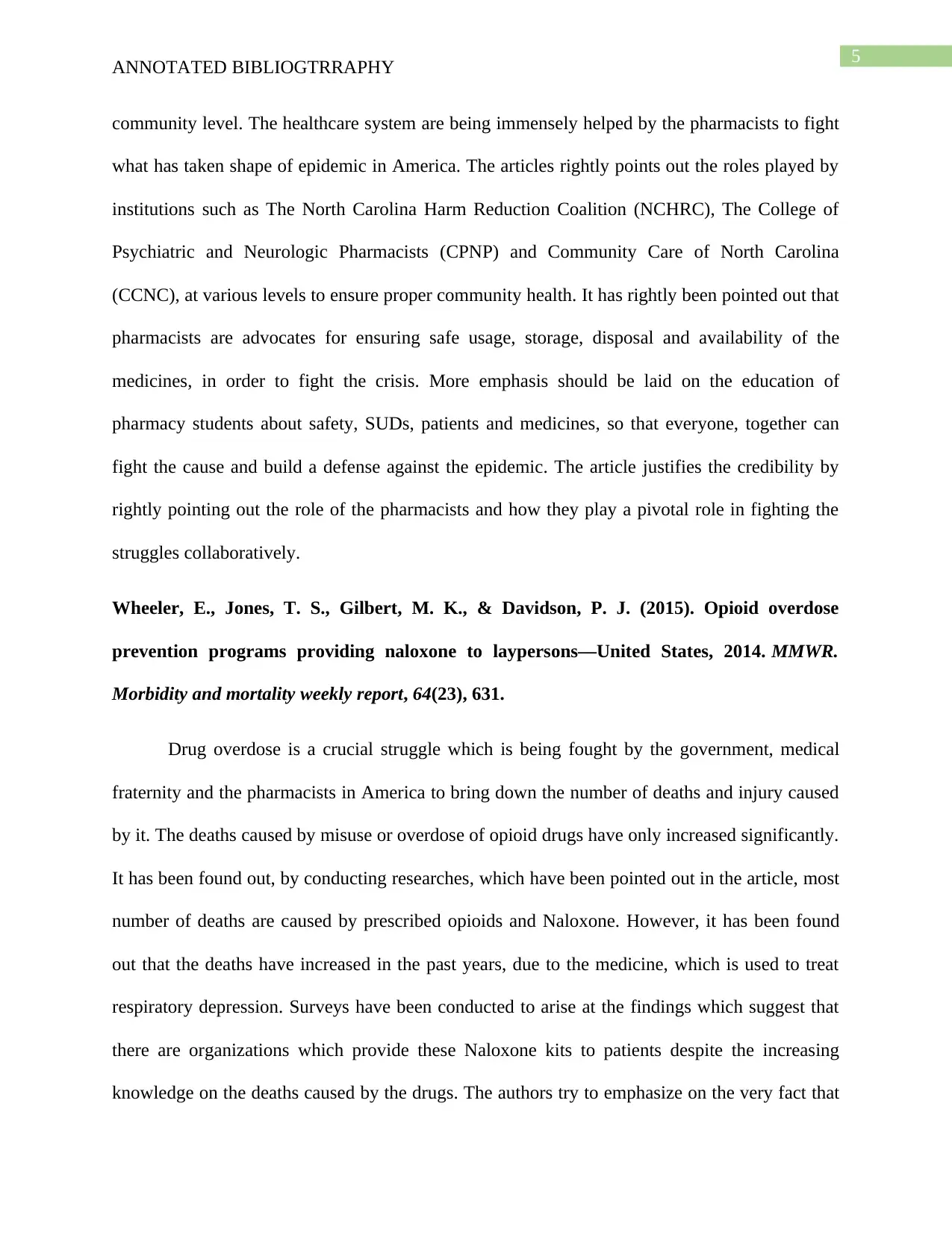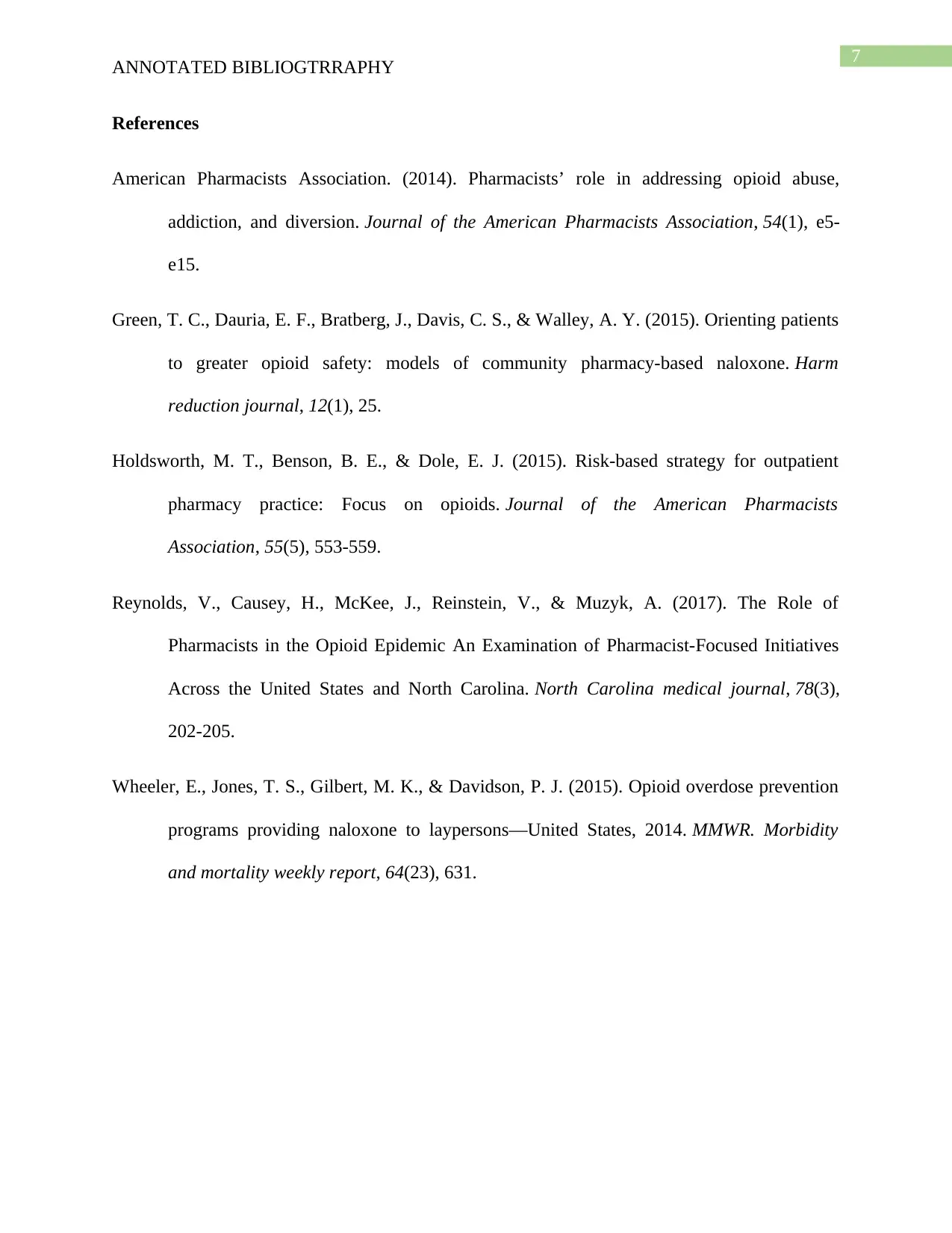Annotated Bibliography: Opioid Crisis, Pharmacists, and Public Health
VerifiedAdded on 2022/09/01
|7
|1690
|16
Annotated Bibliography
AI Summary
This annotated bibliography examines the opioid crisis and the pivotal role pharmacists play in addressing it. The bibliography includes five articles focusing on various aspects of the crisis, such as the misuse of opioid drugs, pharmacists' responsibilities in regulating prescriptions, strategies for managing and controlling opioid usage, and initiatives to prevent overdoses. The articles highlight the importance of pharmacist-led interventions, including scrutiny of prescriptions, patient monitoring, and community-based programs. Key themes include the impact of the opioid epidemic on public health, the effectiveness of naloxone programs, and the development of risk-based strategies in pharmacy practice. The bibliography emphasizes the need for pharmacists to advocate for safe medication practices, educate patients, and collaborate with healthcare systems to combat the crisis. The sources utilize both primary and secondary data to support their arguments, offering insights into the challenges and potential solutions for managing opioid addiction and its consequences.

Running head: ANNOTATED BIBLIOGTRRAPHY
Annotated Bibliography
Name of the Student:
Name of University:
Author Note
Annotated Bibliography
Name of the Student:
Name of University:
Author Note
Paraphrase This Document
Need a fresh take? Get an instant paraphrase of this document with our AI Paraphraser

2
ANNOTATED BIBLIOGTRRAPHY
American Pharmacists Association. (2014). Pharmacists’ role in addressing opioid abuse,
addiction, and diversion. Journal of the American Pharmacists Association, 54(1), e5-e15.
The article discusses the misuse of opioid drugs and how pharmacists play a very
important role in the process of regulating the practice. The responsibilities also lie with the
pharmacists, to ensure that these drugs are not easily purchased by the people who often engage
in unfair practice or usage of the same. The author has also underlined how guidelines and laws
are extremely important to monitor as well as control the accessibility of these drugs. Data,
which has been used for conducting the research include American Pharmacists Association’s
information, which were presented at conferences and workgroups.
The author has rightly pointed out about the increasing usage of opioid drugs. It has
contributed to deterioration of public health, to such an extent that there have been instances of
death, caused due to overdose and accidents on road. There are several strategies which can be
adopted by the pharmacists, in order to address the issue, which include scrutiny of the
prescriptions, monitoring of the patients who require opioid medicines and control and well
management of the people who have been found abusing, misusing and engaging in diversion.
The article. The article points out very essential aspects to effectively manage and control the
usage of such drugs. The article does not contain primary data to substantiate various arguments
which have been placed, but have been credited with secondary data. It contributes to the broader
study and can help pharmacists monitor such usages.
ANNOTATED BIBLIOGTRRAPHY
American Pharmacists Association. (2014). Pharmacists’ role in addressing opioid abuse,
addiction, and diversion. Journal of the American Pharmacists Association, 54(1), e5-e15.
The article discusses the misuse of opioid drugs and how pharmacists play a very
important role in the process of regulating the practice. The responsibilities also lie with the
pharmacists, to ensure that these drugs are not easily purchased by the people who often engage
in unfair practice or usage of the same. The author has also underlined how guidelines and laws
are extremely important to monitor as well as control the accessibility of these drugs. Data,
which has been used for conducting the research include American Pharmacists Association’s
information, which were presented at conferences and workgroups.
The author has rightly pointed out about the increasing usage of opioid drugs. It has
contributed to deterioration of public health, to such an extent that there have been instances of
death, caused due to overdose and accidents on road. There are several strategies which can be
adopted by the pharmacists, in order to address the issue, which include scrutiny of the
prescriptions, monitoring of the patients who require opioid medicines and control and well
management of the people who have been found abusing, misusing and engaging in diversion.
The article. The article points out very essential aspects to effectively manage and control the
usage of such drugs. The article does not contain primary data to substantiate various arguments
which have been placed, but have been credited with secondary data. It contributes to the broader
study and can help pharmacists monitor such usages.

3
ANNOTATED BIBLIOGTRRAPHY
Green, T. C., Dauria, E. F., Bratberg, J., Davis, C. S., & Walley, A. Y. (2015). Orienting
patients to greater opioid safety: models of community pharmacy-based naloxone. Harm
reduction journal, 12(1), 25.
The author investigates the leading cause of death and injury in America to find it to be
because of excessive consumption of opioid drugs. It is a global issues, which seems to be
increasing in various parts of the world, even though, it is much higher in America, as compared
to other parts of the world. The government takes several measures to ensure that these drugs are
made available to the patients on if they possess prescriptions stating the need of the same. The
drugs are even prescribed after making several considerations. The pharmacies also play great
role in the cause as they are trained efficiently to manage and detect medicinal errors. In order to
address the issues, several steps such as patient counselling is conducted to understand how they
interact with medications. The article has correctly underline the very many initiatives and steps
which are taken by the US government to stop overdose or misuse of opioid drugs.
The article is very exemplary to understand how the government ensures, through various
policies, to reduce the usage of opioid drugs and develop framework to be followed by the
pharmacies in order to improve and ensure safety of the patients. The author has investigated and
discussed few policies which are implemented in the States to build up the Collaborative
Pharmacy Practice Agreements and Pharmacy Standing Orders. Various data have been used in
order to assert the arguments, which include death rates caused by naloxone and figuratively
explaining the Medication Receipt Protocol to be followed in order to acquire such medicines.
The article is credible and contributes to the border research scopes as well as the government to
develop newer policies for regulating the issue.
ANNOTATED BIBLIOGTRRAPHY
Green, T. C., Dauria, E. F., Bratberg, J., Davis, C. S., & Walley, A. Y. (2015). Orienting
patients to greater opioid safety: models of community pharmacy-based naloxone. Harm
reduction journal, 12(1), 25.
The author investigates the leading cause of death and injury in America to find it to be
because of excessive consumption of opioid drugs. It is a global issues, which seems to be
increasing in various parts of the world, even though, it is much higher in America, as compared
to other parts of the world. The government takes several measures to ensure that these drugs are
made available to the patients on if they possess prescriptions stating the need of the same. The
drugs are even prescribed after making several considerations. The pharmacies also play great
role in the cause as they are trained efficiently to manage and detect medicinal errors. In order to
address the issues, several steps such as patient counselling is conducted to understand how they
interact with medications. The article has correctly underline the very many initiatives and steps
which are taken by the US government to stop overdose or misuse of opioid drugs.
The article is very exemplary to understand how the government ensures, through various
policies, to reduce the usage of opioid drugs and develop framework to be followed by the
pharmacies in order to improve and ensure safety of the patients. The author has investigated and
discussed few policies which are implemented in the States to build up the Collaborative
Pharmacy Practice Agreements and Pharmacy Standing Orders. Various data have been used in
order to assert the arguments, which include death rates caused by naloxone and figuratively
explaining the Medication Receipt Protocol to be followed in order to acquire such medicines.
The article is credible and contributes to the border research scopes as well as the government to
develop newer policies for regulating the issue.
⊘ This is a preview!⊘
Do you want full access?
Subscribe today to unlock all pages.

Trusted by 1+ million students worldwide

4
ANNOTATED BIBLIOGTRRAPHY
Holdsworth, M. T., Benson, B. E., & Dole, E. J. (2015). Risk-based strategy for outpatient
pharmacy practice: Focus on opioids. Journal of the American Pharmacists
Association, 55(5), 553-559.
The author has intended to highlight the shortcomings of the practices which are carried
out and adopted by the pharmacies in a community. The author has studies the current situation
in America, that there are high number of cases which involve drug misadventures. The most
used drugs include opioids and therapeutic index drugs. The existing models which are adopted
and even proposed primarily focus on controlling the issue while neglecting the problems of the
patients which result in mortality and morbidity. Even though the pharmacists are provided
trainings to ensure proper distribution of drugs to control accessibility rather than making the
usage a normal way of living among people. However, the authors have researched to found
flaws which lie within the system and are contributing factors to the growing cause. Thus, the
authors have proposed a new model which can be immensely beneficial as it involves risk based
strategies which intend to offer educations to the patients on optimal usage and the outcomes of
usages of the drugs in an unmitigated manner.
Reynolds, V., Causey, H., McKee, J., Reinstein, V., & Muzyk, A. (2017). The Role of
Pharmacists in the Opioid Epidemic An Examination of Pharmacist-Focused Initiatives
Across the United States and North Carolina. North Carolina medical journal, 78(3), 202-
205.
It has been pointed out how the pharmacies are helping in controlling the number deaths
and injury which are caused due to the consumption of opioid drugs. The authors contribute to
the broader field of study to address the cause, by investigating the roles which are played by the
pharmacists to control the practice, consumption and accessibility of the medicines at the
ANNOTATED BIBLIOGTRRAPHY
Holdsworth, M. T., Benson, B. E., & Dole, E. J. (2015). Risk-based strategy for outpatient
pharmacy practice: Focus on opioids. Journal of the American Pharmacists
Association, 55(5), 553-559.
The author has intended to highlight the shortcomings of the practices which are carried
out and adopted by the pharmacies in a community. The author has studies the current situation
in America, that there are high number of cases which involve drug misadventures. The most
used drugs include opioids and therapeutic index drugs. The existing models which are adopted
and even proposed primarily focus on controlling the issue while neglecting the problems of the
patients which result in mortality and morbidity. Even though the pharmacists are provided
trainings to ensure proper distribution of drugs to control accessibility rather than making the
usage a normal way of living among people. However, the authors have researched to found
flaws which lie within the system and are contributing factors to the growing cause. Thus, the
authors have proposed a new model which can be immensely beneficial as it involves risk based
strategies which intend to offer educations to the patients on optimal usage and the outcomes of
usages of the drugs in an unmitigated manner.
Reynolds, V., Causey, H., McKee, J., Reinstein, V., & Muzyk, A. (2017). The Role of
Pharmacists in the Opioid Epidemic An Examination of Pharmacist-Focused Initiatives
Across the United States and North Carolina. North Carolina medical journal, 78(3), 202-
205.
It has been pointed out how the pharmacies are helping in controlling the number deaths
and injury which are caused due to the consumption of opioid drugs. The authors contribute to
the broader field of study to address the cause, by investigating the roles which are played by the
pharmacists to control the practice, consumption and accessibility of the medicines at the
Paraphrase This Document
Need a fresh take? Get an instant paraphrase of this document with our AI Paraphraser

5
ANNOTATED BIBLIOGTRRAPHY
community level. The healthcare system are being immensely helped by the pharmacists to fight
what has taken shape of epidemic in America. The articles rightly points out the roles played by
institutions such as The North Carolina Harm Reduction Coalition (NCHRC), The College of
Psychiatric and Neurologic Pharmacists (CPNP) and Community Care of North Carolina
(CCNC), at various levels to ensure proper community health. It has rightly been pointed out that
pharmacists are advocates for ensuring safe usage, storage, disposal and availability of the
medicines, in order to fight the crisis. More emphasis should be laid on the education of
pharmacy students about safety, SUDs, patients and medicines, so that everyone, together can
fight the cause and build a defense against the epidemic. The article justifies the credibility by
rightly pointing out the role of the pharmacists and how they play a pivotal role in fighting the
struggles collaboratively.
Wheeler, E., Jones, T. S., Gilbert, M. K., & Davidson, P. J. (2015). Opioid overdose
prevention programs providing naloxone to laypersons—United States, 2014. MMWR.
Morbidity and mortality weekly report, 64(23), 631.
Drug overdose is a crucial struggle which is being fought by the government, medical
fraternity and the pharmacists in America to bring down the number of deaths and injury caused
by it. The deaths caused by misuse or overdose of opioid drugs have only increased significantly.
It has been found out, by conducting researches, which have been pointed out in the article, most
number of deaths are caused by prescribed opioids and Naloxone. However, it has been found
out that the deaths have increased in the past years, due to the medicine, which is used to treat
respiratory depression. Surveys have been conducted to arise at the findings which suggest that
there are organizations which provide these Naloxone kits to patients despite the increasing
knowledge on the deaths caused by the drugs. The authors try to emphasize on the very fact that
ANNOTATED BIBLIOGTRRAPHY
community level. The healthcare system are being immensely helped by the pharmacists to fight
what has taken shape of epidemic in America. The articles rightly points out the roles played by
institutions such as The North Carolina Harm Reduction Coalition (NCHRC), The College of
Psychiatric and Neurologic Pharmacists (CPNP) and Community Care of North Carolina
(CCNC), at various levels to ensure proper community health. It has rightly been pointed out that
pharmacists are advocates for ensuring safe usage, storage, disposal and availability of the
medicines, in order to fight the crisis. More emphasis should be laid on the education of
pharmacy students about safety, SUDs, patients and medicines, so that everyone, together can
fight the cause and build a defense against the epidemic. The article justifies the credibility by
rightly pointing out the role of the pharmacists and how they play a pivotal role in fighting the
struggles collaboratively.
Wheeler, E., Jones, T. S., Gilbert, M. K., & Davidson, P. J. (2015). Opioid overdose
prevention programs providing naloxone to laypersons—United States, 2014. MMWR.
Morbidity and mortality weekly report, 64(23), 631.
Drug overdose is a crucial struggle which is being fought by the government, medical
fraternity and the pharmacists in America to bring down the number of deaths and injury caused
by it. The deaths caused by misuse or overdose of opioid drugs have only increased significantly.
It has been found out, by conducting researches, which have been pointed out in the article, most
number of deaths are caused by prescribed opioids and Naloxone. However, it has been found
out that the deaths have increased in the past years, due to the medicine, which is used to treat
respiratory depression. Surveys have been conducted to arise at the findings which suggest that
there are organizations which provide these Naloxone kits to patients despite the increasing
knowledge on the deaths caused by the drugs. The authors try to emphasize on the very fact that

6
ANNOTATED BIBLIOGTRRAPHY
these might lead to overdose or overdose reversals leading to deaths. Administration is important
on opioid prescription and usages, thus. The article is extremely useful and credible for
understanding the risks which are contained within the system and can help fight the crisis.
ANNOTATED BIBLIOGTRRAPHY
these might lead to overdose or overdose reversals leading to deaths. Administration is important
on opioid prescription and usages, thus. The article is extremely useful and credible for
understanding the risks which are contained within the system and can help fight the crisis.
⊘ This is a preview!⊘
Do you want full access?
Subscribe today to unlock all pages.

Trusted by 1+ million students worldwide

7
ANNOTATED BIBLIOGTRRAPHY
References
American Pharmacists Association. (2014). Pharmacists’ role in addressing opioid abuse,
addiction, and diversion. Journal of the American Pharmacists Association, 54(1), e5-
e15.
Green, T. C., Dauria, E. F., Bratberg, J., Davis, C. S., & Walley, A. Y. (2015). Orienting patients
to greater opioid safety: models of community pharmacy-based naloxone. Harm
reduction journal, 12(1), 25.
Holdsworth, M. T., Benson, B. E., & Dole, E. J. (2015). Risk-based strategy for outpatient
pharmacy practice: Focus on opioids. Journal of the American Pharmacists
Association, 55(5), 553-559.
Reynolds, V., Causey, H., McKee, J., Reinstein, V., & Muzyk, A. (2017). The Role of
Pharmacists in the Opioid Epidemic An Examination of Pharmacist-Focused Initiatives
Across the United States and North Carolina. North Carolina medical journal, 78(3),
202-205.
Wheeler, E., Jones, T. S., Gilbert, M. K., & Davidson, P. J. (2015). Opioid overdose prevention
programs providing naloxone to laypersons—United States, 2014. MMWR. Morbidity
and mortality weekly report, 64(23), 631.
ANNOTATED BIBLIOGTRRAPHY
References
American Pharmacists Association. (2014). Pharmacists’ role in addressing opioid abuse,
addiction, and diversion. Journal of the American Pharmacists Association, 54(1), e5-
e15.
Green, T. C., Dauria, E. F., Bratberg, J., Davis, C. S., & Walley, A. Y. (2015). Orienting patients
to greater opioid safety: models of community pharmacy-based naloxone. Harm
reduction journal, 12(1), 25.
Holdsworth, M. T., Benson, B. E., & Dole, E. J. (2015). Risk-based strategy for outpatient
pharmacy practice: Focus on opioids. Journal of the American Pharmacists
Association, 55(5), 553-559.
Reynolds, V., Causey, H., McKee, J., Reinstein, V., & Muzyk, A. (2017). The Role of
Pharmacists in the Opioid Epidemic An Examination of Pharmacist-Focused Initiatives
Across the United States and North Carolina. North Carolina medical journal, 78(3),
202-205.
Wheeler, E., Jones, T. S., Gilbert, M. K., & Davidson, P. J. (2015). Opioid overdose prevention
programs providing naloxone to laypersons—United States, 2014. MMWR. Morbidity
and mortality weekly report, 64(23), 631.
1 out of 7
Related Documents
Your All-in-One AI-Powered Toolkit for Academic Success.
+13062052269
info@desklib.com
Available 24*7 on WhatsApp / Email
![[object Object]](/_next/static/media/star-bottom.7253800d.svg)
Unlock your academic potential
Copyright © 2020–2025 A2Z Services. All Rights Reserved. Developed and managed by ZUCOL.





